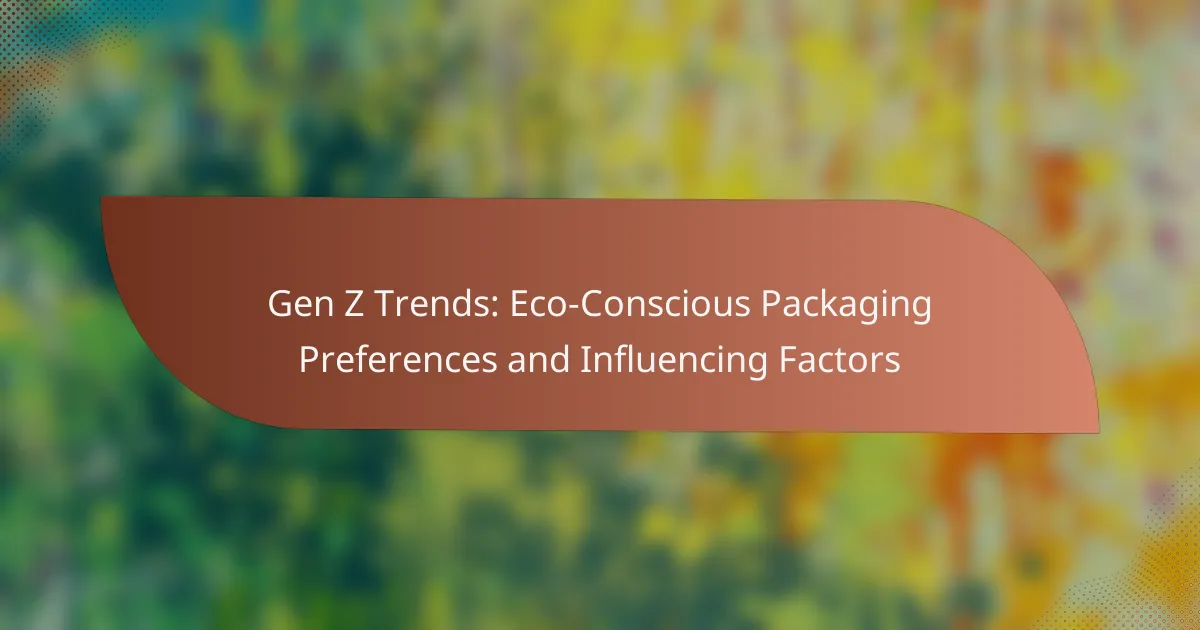Gen Z in the US is driving a significant shift towards eco-conscious packaging, reflecting their commitment to sustainability and environmental responsibility. This generation favors biodegradable materials, reusable options, and minimalist designs, seeking brands that align with their values of social responsibility and ethical practices.
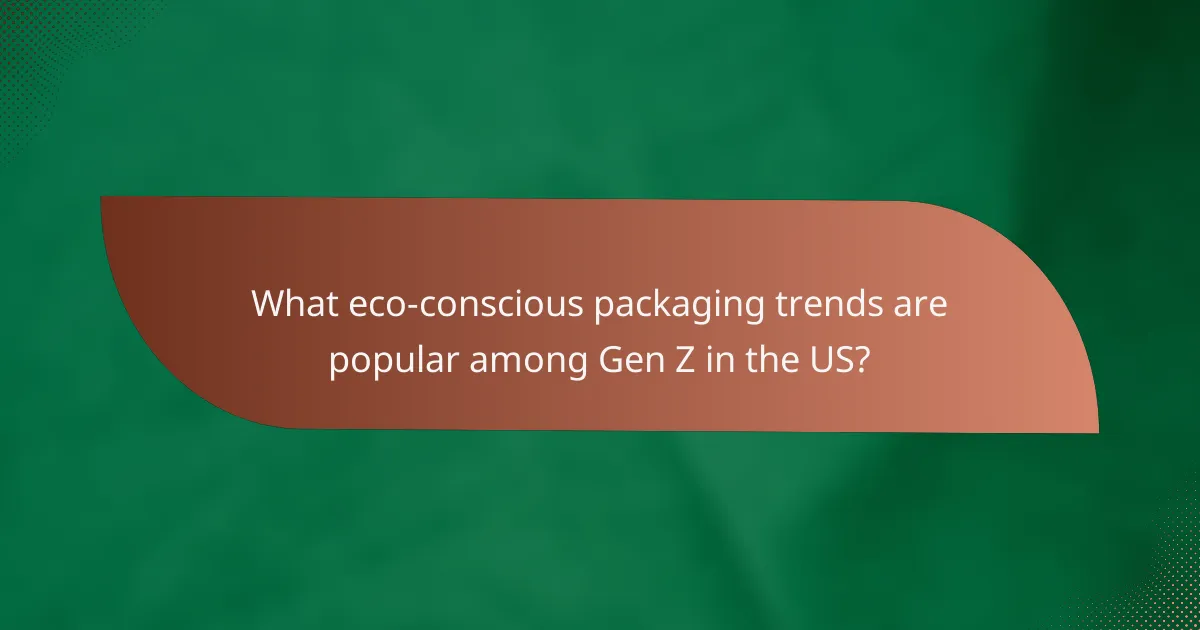
What eco-conscious packaging trends are popular among Gen Z in the US?
Gen Z in the US is increasingly favoring eco-conscious packaging that aligns with their values of sustainability and environmental responsibility. Key trends include biodegradable materials, reusable packaging, minimalist design, plant-based inks, and recyclable options, all reflecting a shift towards reducing waste and promoting a circular economy.
Biodegradable materials
Biodegradable materials are gaining traction among Gen Z consumers who prefer packaging that breaks down naturally and minimizes environmental impact. Common options include plant-based plastics, paper, and compostable materials that decompose within a few months under proper conditions.
Brands can enhance their appeal by clearly labeling biodegradable products and providing information on how to dispose of them correctly. This transparency helps build trust and encourages responsible consumer behavior.
Reusable packaging
Reusable packaging is a significant trend as Gen Z seeks to reduce single-use waste. This includes containers designed for multiple uses, such as glass jars, metal tins, and durable bags that can be refilled or repurposed.
Companies can implement take-back programs or incentivize customers to return packaging for reuse, fostering a sense of community and environmental stewardship. Highlighting the longevity and versatility of reusable options can further attract eco-conscious buyers.
Minimalist design
Minimalist design is favored by Gen Z for its aesthetic appeal and reduced material usage. Clean lines, simple graphics, and limited color palettes not only convey a modern look but also signify a commitment to sustainability.
Brands can adopt minimalist packaging by focusing on essential information and eliminating excess materials. This approach not only resonates with consumers but can also lower production costs and waste.
Plant-based inks
Plant-based inks are becoming a popular choice for eco-conscious packaging, as they are derived from renewable resources and are less harmful to the environment compared to traditional petroleum-based inks. These inks often have lower VOC emissions, making them a healthier option for both consumers and the planet.
Brands should consider using plant-based inks for their packaging to enhance their sustainability profile. Clearly communicating this choice can attract environmentally aware customers who prioritize green practices.
Recyclable options
Recyclable packaging remains a key preference for Gen Z, who are keen on reducing landfill waste. Materials such as cardboard, glass, and certain plastics are often favored for their recyclability, provided they are clearly marked with recycling symbols.
To appeal to this demographic, brands should ensure their packaging is easily recyclable and educate consumers on local recycling guidelines. Offering incentives for returning packaging can further encourage responsible disposal and recycling practices.

How do Gen Z values influence their packaging preferences?
Gen Z prioritizes eco-conscious packaging due to their strong values around sustainability, social responsibility, and ethical practices. Their preferences reflect a desire for brands that align with their commitment to environmental and social issues.
Environmental sustainability
Environmental sustainability is a core value for Gen Z, driving their preference for packaging that minimizes ecological impact. They favor materials that are recyclable, biodegradable, or made from post-consumer waste.
Brands can appeal to this demographic by adopting sustainable packaging practices, such as using plant-based plastics or reducing excess packaging. Clear labeling about the environmental benefits of packaging can enhance appeal.
Social responsibility
Gen Z consumers expect brands to demonstrate social responsibility through their packaging choices. This includes considerations like fair labor practices and community engagement in the production process.
Brands that support local communities or contribute to social causes can resonate more with Gen Z. Highlighting these efforts on packaging or marketing materials can strengthen brand loyalty among this group.
Brand transparency
Brand transparency is crucial for Gen Z, who prefer companies that openly communicate their sourcing and manufacturing processes. They are more likely to support brands that provide clear information about their packaging materials and environmental impact.
To foster trust, brands should consider using QR codes on packaging that link to detailed information about their sustainability practices. This transparency can enhance consumer confidence and loyalty.
Ethical sourcing
Ethical sourcing is a significant factor in Gen Z’s packaging preferences, as they seek products that are produced responsibly. This includes ensuring that materials are sourced from suppliers who adhere to ethical labor practices and environmental standards.
Brands can improve their appeal by showcasing certifications or partnerships with organizations that promote ethical sourcing. Clear communication about these practices can differentiate a brand in a crowded market.
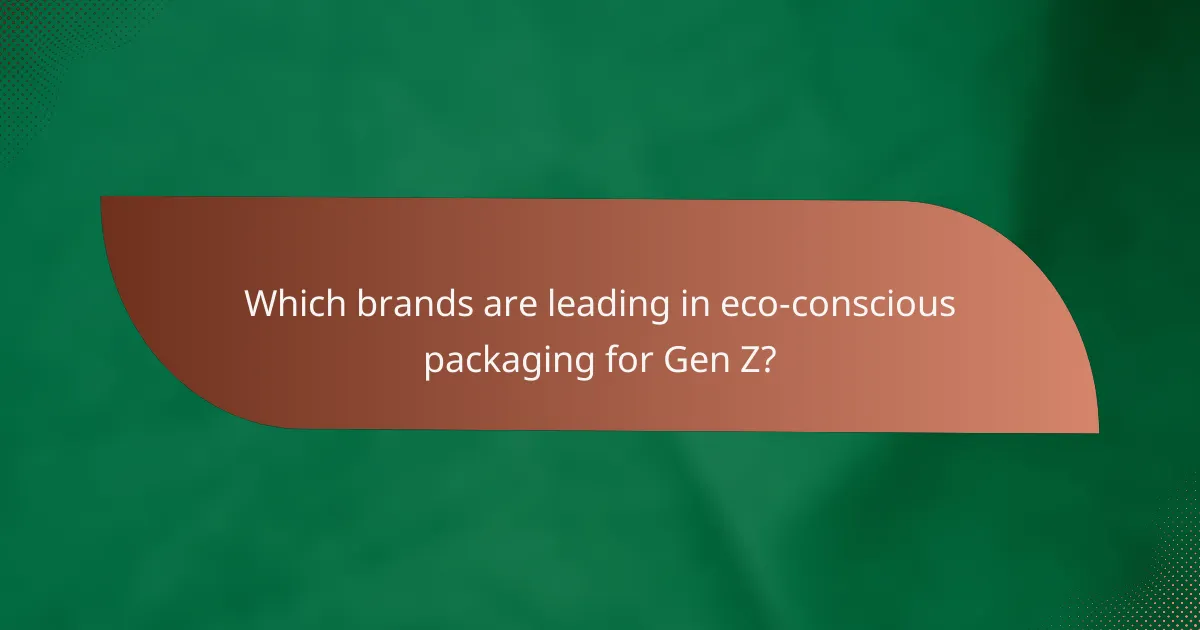
Which brands are leading in eco-conscious packaging for Gen Z?
Several brands are setting the standard for eco-conscious packaging that resonates with Gen Z consumers. These brands prioritize sustainability in their packaging choices, appealing to the values of this environmentally aware generation.
Patagonia
Patagonia is renowned for its commitment to environmental sustainability, which extends to its packaging. The brand uses recycled materials for its shipping boxes and encourages customers to recycle or reuse packaging. Their transparency about sourcing and sustainability practices builds trust with Gen Z consumers.
Additionally, Patagonia promotes a circular economy by offering repair services for its products, reducing waste and encouraging longer product lifespans. This approach aligns with Gen Z’s preference for brands that prioritize environmental responsibility.
Allbirds
Allbirds has gained popularity for its eco-friendly footwear and packaging. The brand utilizes 90% recycled cardboard for its shoeboxes and employs minimalistic designs that reduce material usage. This not only lowers their carbon footprint but also appeals to Gen Z’s aesthetic preferences for simplicity and sustainability.
Moreover, Allbirds emphasizes transparency in its supply chain, providing information about the materials used in its products. This level of openness resonates with Gen Z, who value brands that demonstrate accountability and environmental stewardship.
Uncommon Goods
Uncommon Goods focuses on sustainable packaging by using recycled materials and eco-friendly inks. The company prioritizes reducing waste by offering products that are often handmade or sourced from sustainable suppliers. This commitment to sustainability attracts Gen Z shoppers looking for unique, environmentally friendly gifts.
Furthermore, Uncommon Goods actively encourages customers to recycle packaging materials, reinforcing their eco-conscious message. Their efforts in promoting sustainable practices align well with Gen Z’s values and purchasing decisions.
Seventh Generation
Seventh Generation is a leader in the eco-friendly cleaning products market, known for its commitment to sustainable packaging. The brand uses recycled plastic for its bottles and aims for 100% recyclable packaging by 2025. This commitment to sustainability is crucial for attracting Gen Z consumers who prioritize eco-friendly products.
In addition, Seventh Generation advocates for environmental policies and practices, further enhancing its appeal to socially conscious Gen Z shoppers. Their focus on transparency and sustainability resonates with this demographic’s desire for responsible consumption.
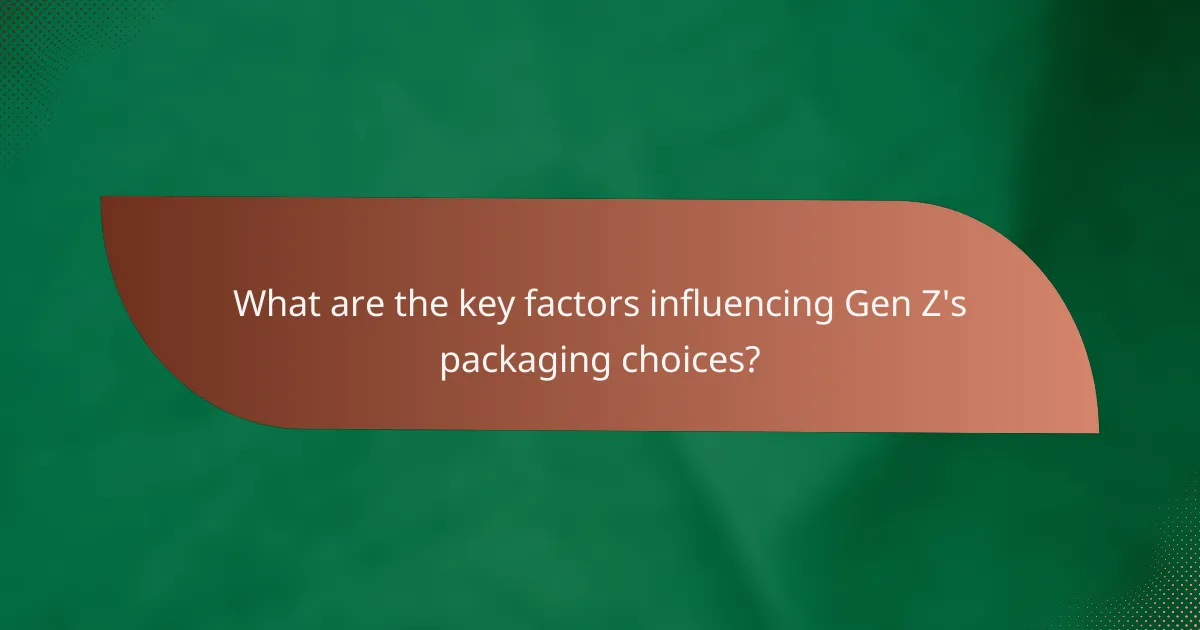
What are the key factors influencing Gen Z’s packaging choices?
Gen Z’s packaging choices are primarily influenced by their values around sustainability, cost, and social dynamics. They tend to favor eco-conscious options that align with their environmental concerns while also considering price and peer opinions.
Price sensitivity
Price sensitivity plays a crucial role in Gen Z’s packaging preferences. Many in this demographic are students or early in their careers, meaning they often operate within tight budgets. They are likely to choose products with sustainable packaging only if the price difference is minimal compared to conventional options.
Brands can appeal to this group by offering competitive pricing on eco-friendly products, potentially using promotions or discounts to encourage trial. For instance, a product priced within a few dollars of its non-sustainable counterpart may attract more Gen Z consumers.
Product availability
Product availability significantly affects Gen Z’s packaging choices. If eco-friendly packaging options are not readily available in stores or online, this generation may opt for traditional packaging instead. Convenience is key; they prefer brands that offer sustainable choices alongside their regular products.
Retailers can enhance accessibility by stocking a variety of eco-conscious products and clearly labeling them. Collaborations with brands that prioritize sustainability can also expand offerings and attract Gen Z shoppers.
Peer influence
Peer influence is a strong factor in Gen Z’s decision-making regarding packaging. This generation often seeks validation from friends and social circles, making them more likely to choose brands that are popular among their peers. If a product is endorsed by friends or influencers, its eco-friendly packaging can become a selling point.
Brands should consider leveraging social proof, such as testimonials or influencer partnerships, to highlight their sustainable packaging. Creating a community around eco-conscious choices can further engage this demographic.
Social media trends
Social media trends heavily impact Gen Z’s packaging preferences. Platforms like Instagram and TikTok can amplify awareness of sustainable packaging, making it a trendy choice. Visual appeal is essential; products with attractive, eco-friendly packaging are more likely to be shared and promoted online.
Brands should focus on creating visually appealing packaging that resonates with social media aesthetics. Engaging in social media campaigns that highlight sustainability can capture the attention of Gen Z and encourage them to choose eco-friendly options.
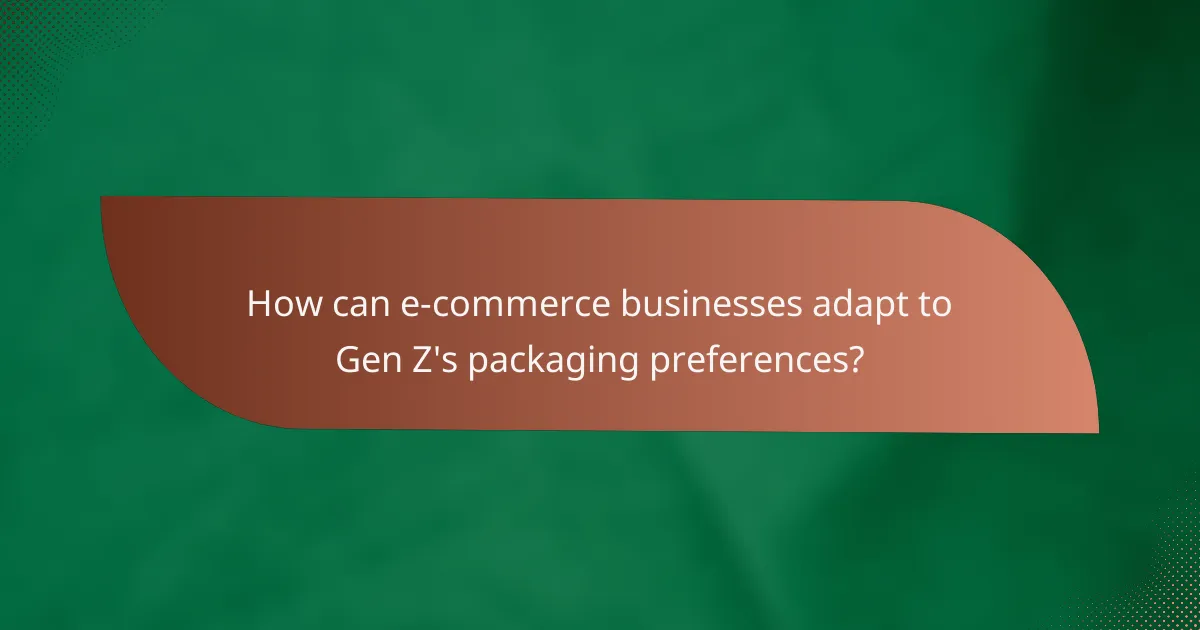
How can e-commerce businesses adapt to Gen Z’s packaging preferences?
E-commerce businesses can adapt to Gen Z’s packaging preferences by prioritizing sustainability and offering customizable options. Understanding these trends is essential for attracting this environmentally-conscious demographic and enhancing customer loyalty.
Implement sustainable practices
To appeal to Gen Z, e-commerce businesses should adopt sustainable packaging materials such as biodegradable plastics, recycled paper, or compostable options. These practices not only reduce environmental impact but also resonate with Gen Z’s values, making them more likely to support brands that align with their beliefs.
Consider using minimal packaging to reduce waste, and ensure that any materials used are easily recyclable. Highlighting certifications like FSC (Forest Stewardship Council) or Cradle to Cradle can further enhance credibility and attract eco-conscious consumers.
Offer customization options
Customization allows customers to personalize their packaging, which can enhance their shopping experience and foster brand loyalty. E-commerce businesses can provide options for customers to choose packaging designs, colors, or even messages, making the unboxing experience more memorable.
Implementing a user-friendly interface for customization on the website can streamline this process. Offering limited edition packaging or seasonal designs can also create excitement and encourage repeat purchases among Gen Z consumers.
